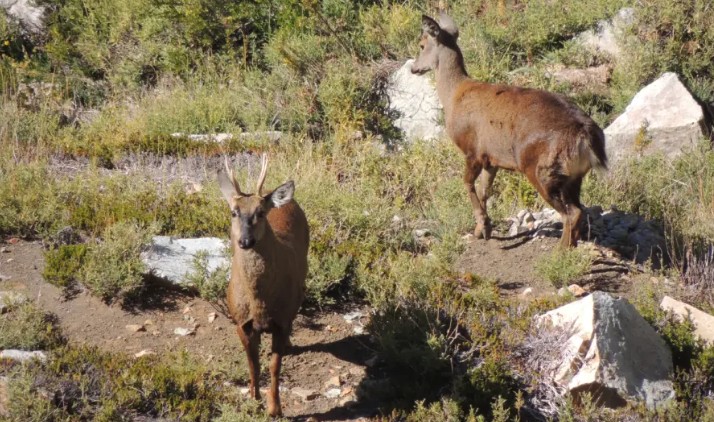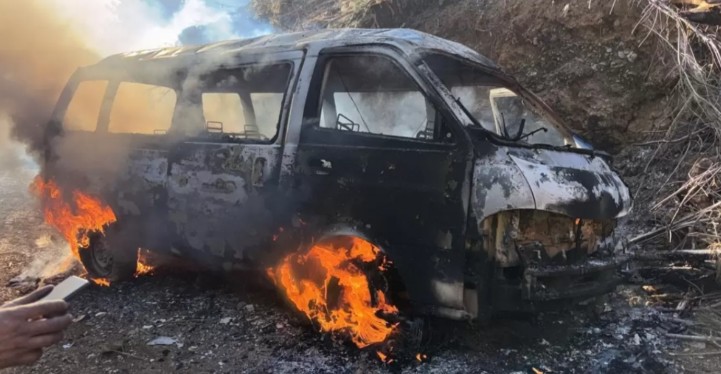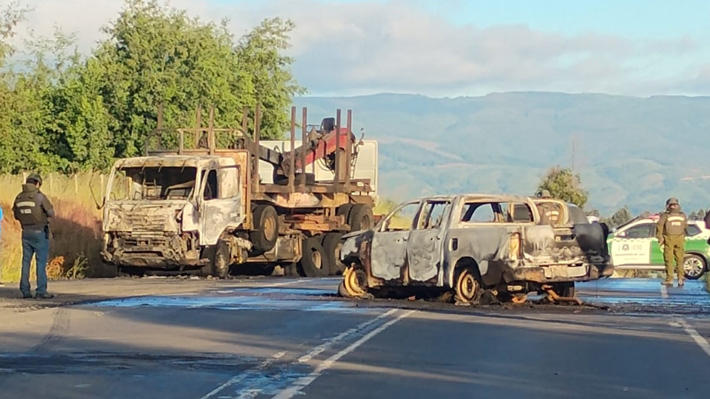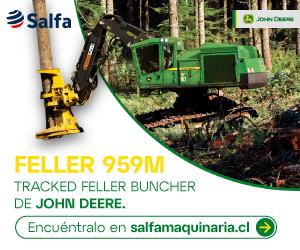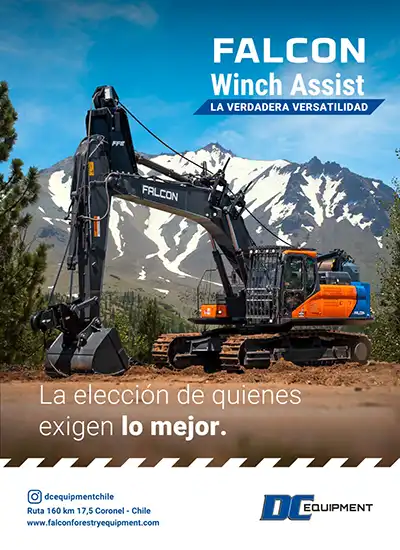Strategy aimed at conserving the huemul has reduced its threats by 58%
The Huemul Recovery, Conservation, and Management Plan (Recoge), approved in 2021, includes over 50 actions involving both public and private sectors to advance the recovery and conservation of this critically endangered species.
The goal of this strategy is to increase the population of this deer in the Nevados de Chillán-Laguna Laja area by 10% within 12 years, through monitoring, procedures, and evaluation by the coordinating institution, the National Forestry Corporation (Conaf), alongside the Ministries of Environment, Public Works, and Energy, as well as Aumed, Codeff, Forestal Arauco, SAG, and the NGO Dosel.
This effort has two main objectives: reducing threats affecting the species, which has achieved 58% progress, and increasing protection, with 65% progress. Both encompass 16 actions in total, which have so far reached varying levels of advancement.
For example, developing technical tools to assess civil projects in areas with huemul habitat or presence (33%), creating and implementing a plan to reduce livestock in huemul breeding zones (83%), and establishing a program for sustainable forestry practices in native forests and plantations in huemul-inhabited areas (67%), among others.
Among measures with 100% completion are local government regulations, control of exotic deer, expansion of breeding sites, and monitoring. Meanwhile, those with no progress include a disease prevention and control program for huemul and implementing a Biosphere management plan related to the animal.
Additionally, the strategy includes developing a binational Argentine-Chilean conservation plan to update a map of their locations and promote strategies to consolidate a biological corridor with protected public and private areas.
In this regard, training sessions are being organized for rangers of the Epu Lauquen Protected Natural Area, who will visit from Argentina in November. Then, in early 2026, a Chilean delegation will travel to the neighboring country to conduct fieldwork focused on huemul monitoring, aiming to support habitat identification.
The progress of the Recoge plan was presented during the "Central Chile Huemul Symposium," held last Tuesday in Chillán, which brought together representatives from public institutions, civil society organizations, and private entities that shared their monitoring results and conservation-related actions in Ñuble and Biobío.
The idea is to safeguard the species from various threats that pressure and impact its habitat and integrity, beyond protected areas like the Ñuble and Huemules de Niblinto Reserves, as it has been confirmed that the huemul moves beyond these boundaries.
"The huemul faces diverse threats in its habitat. For example, climate change, but also vehicle traffic in high mountain areas, as well as livestock, which could eventually transmit diseases—something that requires further investigation. Tourism, increasingly present in this high mountain sector, must also be managed as responsibly as possible. Finally, forest fires, which unfortunately are becoming more frequent and intense," explained Mario Rivas, the Regional Minister of Environment.
The authority assured that these dangers are being addressed "by various public and private services to take concrete actions."
Species in Focus
This task is crucial to protecting huemul families that have been monitored through Conaf's camera traps in conservation areas.
The head of Conaf's Protected Wilderness Areas Department, Mario Valdebenito, highlighted that this technology has helped identify key breeding sites for the species.
"We have identified breeding areas where our camera traps capture images of huemules with offspring. This helps determine their reproduction zones. Within the reserve, these include El Toro, El Potro, and Las Parías ravines, as well as areas near Laguna El Baúl in the Ñuble and Niblinto reserves. All huemules captured by our cameras appear healthy, evident in their body mass and fur, especially during shedding seasons. Everything aligns with our records and available data," he noted.
The local population size remains unknown, as no census has been conducted yet. However, Conaf hopes to acquire suitable technology to determine the exact number of individuals more accurately.
"There are several estimates. Conaf currently lacks an exact number because we don’t have all the tools to conduct a proper census, given the rugged, mountainous terrain, which poses risks. But we are seeking funding to adopt tools like drones, which would allow us, at certain times of the year, to generate more precise population estimates," the professional acknowledged.
From his perspective, the main difference between central and southern huemules is that the former show better health, being less exposed to large livestock concentrations that can transmit diseases.
"Southern huemules have slightly more genetic variability than central ones. In fact, this is because they are a smaller group, making inbreeding more likely. Another difference is that southern huemules have been observed with diseases due to contact with domestic livestock—mainly cows, sheep, or goats—leading to body protrusions or foot ailments. However, in our reserves, where we mitigate threats, we’ve detected no sick huemules. These areas are also larger and near livestock breeding zones," he explained.
The biggest concern lies in lands adjacent to the reserves where huemules roam, as they face risks of disease transmission from private livestock and habitat restrictions for foraging.
"One major pending issue in our region is what happens outside protected areas. These are mountainous zones with various landowners who may bring livestock—a documented threat to huemules due to disease risks. They also fragment the huemul's territory, forcing them into less favorable habitats," Valdebenito commented.
Livestock has been detected in monitoring zones, though not overlapping with huemul areas. Collaborative efforts with SAG have facilitated contacting owners for removal from protected zones.
"Whenever we report livestock sightings or threats to huemules, SAG visits the area with specialists, gathers animal data, and contacts owners to ensure immediate removal. This has worked—livestock hasn’t reappeared after SAG intervention," the Conaf professional stated.
Low Genetic Variability
As an endangered species, the huemul is in sharp decline and could disappear without sustained conservation efforts. Locally, its small population has low genetic diversity, hindering adaptation to environmental changes and increasing extinction risks—especially as it’s isolated, separated by nearly 400 km from southern populations.
According to Dr. Juan Carlos Marín, a researcher at the University of Bío Bío, central huemules are more vulnerable to changes due to limited genetic variability.
"Genetically, we identified nearly 40 distinct individuals. Conaf and other agencies estimate around 50 animals in Central Chile—perhaps up to 100, but that’s very few for such a species. Low diversity promotes inbreeding, increasing the chance of recessive traits—harmful characteristics masked in parents but appearing in offspring. With little diversity, the population lacks resilience to environmental shifts. If all are similar, one change could wipe them out, whereas diversity ensures some survive," he explained.
Beyond numbers, the key is connecting populations via the Nevados de Chillán-Laguna Laja biological corridor to enhance genetic diversity between northern (Niblinto) and southern (Ñuble and Laja Reserves) groups. However, it’s unclear if this is happening.
"It hasn’t been fully analyzed—it may be historical. We can’t resolve this yet. There are at least 50 animals here; we hope for double that. But numbers aren’t everything. Millions of identical animals won’t aid conservation—diversity matters," the UBB professor emphasized.
Alert Citizens
The deer has also drawn civil society’s attention, with groups monitoring the species and coordinating conservation efforts.
For six years, the NGO Dosel in San Fabián has focused on huemules. Through the FIC program, they’ve recorded the species outside protected areas, where threats are higher.
"We’ve found huemules mainly south of Ñuble, with tracks near Lara, close to the future Bullileo National Park. We’re in long-term monitoring and seeking funds to retrieve 18 camera traps for continued work in San Fabián," said Pablo Espinoza Carbullanca of Dosel.
Under Recoge, infrastructure and urbanization projects without huemul conservation considerations are labeled "high" threat and "priority 1."
Aware of these risks, Dosel stressed that balancing projects like the La Punilla dam with conservation is complex, requiring measures aligned with current environmental laws and the huemul’s future.
"Conservation isn’t about halting progress—it’s necessary, but alternatives must be sought. La Punilla dam is in huemul habitat, disrupting connectivity for small populations. A massive reservoir blocking their movement between valleys is critical. If crossing the Ñuble River was hard, a giant lake will make it worse. This affects not just huemules but also low-mobility micromammals displaced from their territory," he warned.
Dosel argues for a new environmental impact study, as the 2010-approved one doesn’t meet current standards. An updated huemul map must also be considered. "We hope it’s redone," Espinoza urged.
The Los Mallines Foundation has joined monitoring efforts, documenting huemules near Jungla Pumayén Park.
"In Mallines Alto Andino, we’ve seen family groups of 2-3 individuals for three years. They show no signs of disease or malnutrition," said Christopher Hoefler, the foundation’s project director.
From his view, infrastructure projects must align with conservation demands via updated biodiversity offsets under Recoge, requiring dialogue with stakeholders.
"First, foster dialogue, align economic and environmental incentives, and enforce regulations. The Biodiversity Service (SBAP) is advancing compensation rules, and Recoge’s indicators are being tracked. Landowners act for economic reasons, so solutions like biodiversity or carbon offsets can prevent harmful projects," he said.
Source:La Discusión


